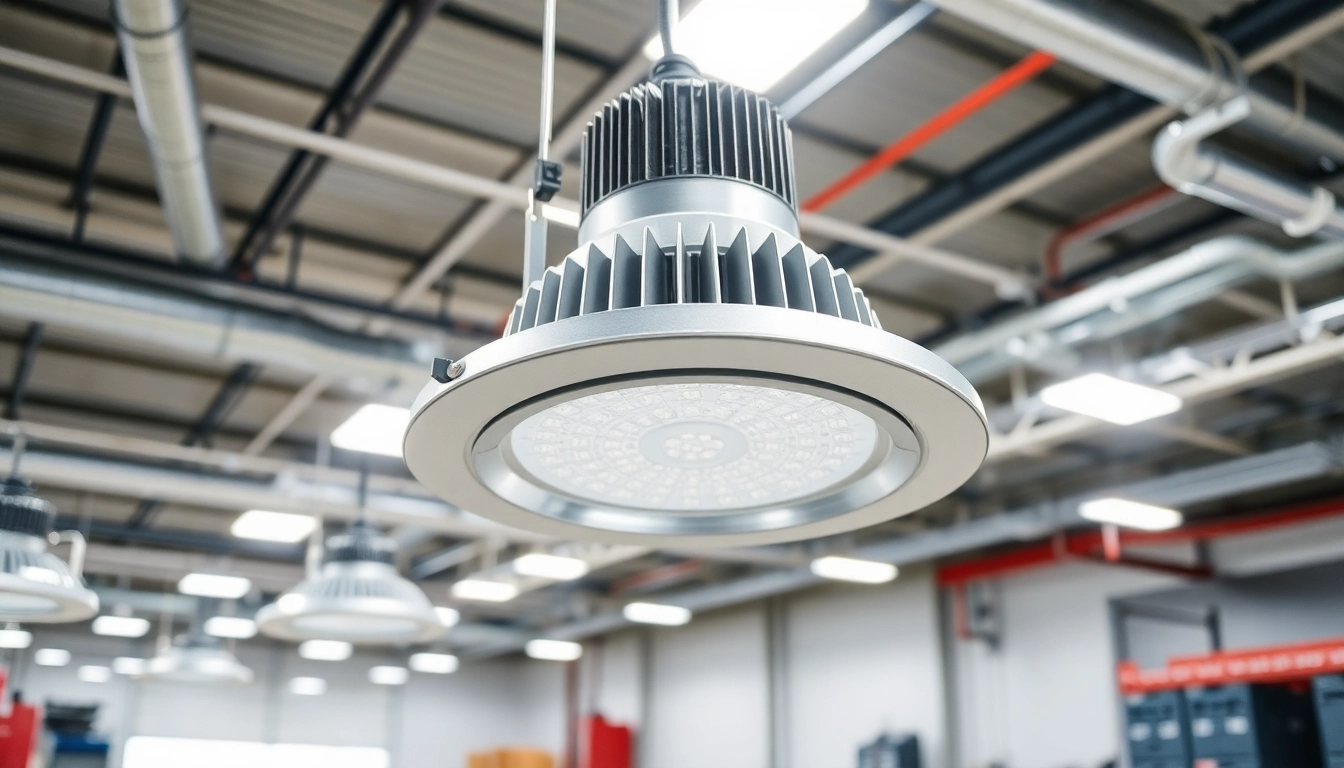Introduction to LED Vapor Tight
In the world of lighting, efficiency and durability are of utmost importance, particularly in environments that pose unique challenges. LED vapor tight fixtures emerge as a solution specifically designed to thrive in such conditions, offering superior functionality and reliability. These fixtures are engineered to withstand moisture, dust, and various environmental factors, making them ideal for both indoor and outdoor applications. The demand for reliable lighting solutions has spurred interest in LED Vapor Tight products, combining energy efficiency with robust performance.
What is LED Vapor Tight?
LED vapor tight fixtures are lighting solutions that are constructed to protect against the ingress of water and dust. Typically sealed with gaskets and constructed from durable materials such as polycarbonate or fiberglass, these fixtures are designed to be resistant to impact and corrosion. This makes them suitable for tight spaces and harsh environments such as warehouses, cold storage facilities, garages, and even outdoor settings exposed to changing weather conditions. The key to their effectiveness lies in the combination of LED technology with a design that prioritizes both lighting performance and environmental resistance.
Advantages of Using LED Vapor Tight
- Energy Efficiency: LED technology is renowned for its low energy consumption compared to traditional lighting solutions. This results in lower electricity bills and a reduced carbon footprint.
- Longevity: LED vapor tight fixtures have an extended lifespan, often lasting upwards of 50,000 hours. This significantly reduces the need for frequent replacements and maintenance.
- Durability: Built to withstand extreme conditions, these fixtures are resistant to moisture, dust, and impacts, making them ideal for challenging environments.
- Improved Safety: By providing bright, even illumination, LED vapor tight fixtures enhance visibility, reducing the risk of accidents in work environments.
- Versatility: These fixtures can be used in various applications, from industrial to residential settings, providing flexibility for different lighting needs.
Applications of LED Vapor Tight Lighting
The utilization of LED vapor tight lighting extends across a broad spectrum of environments and sectors. Here are a few notable applications:
- Industrial Facilities: Ideal for factories and warehouses where dust and moisture are prevalent.
- Food Processing Plants: Essential for maintaining hygiene while providing adequate lighting for work operations.
- Parking Garages: Offers a secure and well-lit environment for vehicles and pedestrians.
- Agricultural Settings: Suitable for barns and greenhouses, where humidity levels can be high.
- Outdoor Environments: Perfect for illuminating walkways, entrances, and loading docks exposed to the elements.
Choosing the Right LED Vapor Tight
Selecting the right LED vapor tight fixture involves a careful assessment of various factors that align with specific needs and conditions. Understanding what you require is crucial in making an informed choice.
Factors to Consider in Selection
- Environment: Analyze whether the fixture will be used indoors or outdoors, and assess the environmental conditions, including temperature and humidity levels.
- Lumen Output: Determine the brightness required for the space to ensure adequate illumination for safety and functionality.
- Size and Design: Consider the sizing and aesthetic design to ensure it fits well within the intended location without compromising on performance.
- Energy Efficiency Ratings: Look for fixtures with high efficacy (lumens per watt) to maximize energy savings.
- Color Temperature: Select a color temperature that suits the application, such as warmer tones for residential areas or cooler tones for commercial or industrial uses.
- Ingress Protection (IP) Rating: Choose fixtures with suitable IP ratings to ensure they can withstand exposure to dust and moisture.
Comparing LED Vapor Tight Products
When comparing different LED vapor tight products, it’s essential to evaluate more than just the initial cost. Here are some metrics to consider:
- Warranty: A longer warranty often indicates manufacturer confidence in their product’s durability.
- Reviews and Certifications: Look for third-party certifications to ensure your product meets industry standards and check customer reviews for insights into real-world performance.
- Installation Requirements: Assess whether the product requires specialized installation or tools, which can affect overall project costs.
- Compatibility with Smart Technology: Explore options that can integrate with smart lighting systems, offering advanced controls and energy management features.
Understanding Specifications of LED Vapor Tight
Specifications are vital when evaluating LED vapor tight fixtures. Essential elements include:
- Power Consumption: Measurement of wattage usage which impacts energy costs.
- Lumens: The total amount of visible light emitted by the fixture—a key indicator of brightness.
- Beam Angle: Determines the spread of light; wider angles illuminate larger areas.
- Color Rendering Index (CRI): Indicates how colors appear under the light compared to natural light; a higher CRI means more accurate color representation.
- Construction Material: The material used not only impacts aesthetics but also durability and resistance to weather elements.
Installation Best Practices for LED Vapor Tight
Preparing the Installation Site
- Site Assessment: Conduct a thorough evaluation of the area where the fixture will be installed. Identify any obstacles, access issues, or requirements regarding height and mounting surfaces.
- Power Supply Check: Ensure that the electrical infrastructure can support the new fixtures, focusing on voltage compatibility and available circuits.
- Safety Gear: Equip yourself with appropriate safety gear, including gloves, helmets, and eye protection, to ensure a safe installation process.
Installation Guidelines for LED Vapor Tight
- Follow Manufacturer Instructions: Adhere to specific installation guidelines provided by the manufacturer to avoid compromising the fixture’s integrity or warranty.
- Secure Mounting: Ensure the fixture is securely mounted, using appropriate hardware for the type of surface.
- Electrical Connections: Make electrical connections carefully to avoid any short circuits or hazards. Ensure that connections are properly insulated.
- Test the Fixtures: Before finalizing the installation, power up the fixtures to ensure they operate correctly and provide the expected level of illumination.
Common Mistakes to Avoid
Despite thorough planning, common installation pitfalls may occur. Here are mistakes to avoid:
- Ignoring Site Conditions: Many overlook how temperatures and moisture can affect fixture performance. Always assess environmental conditions in advance.
- Choosing Improper Fixtures: Selecting fixtures not suited for the intended application can lead to inefficient lighting or potential safety hazards.
- Neglecting Regular Maintenance: Underestimating maintenance needs can lead to premature failure; establishing a regular checkup schedule is crucial.
- Overloading Circuits: Ensure that the total wattage of installed fixtures does not exceed circuit capacity to avoid electrical failures and potential fires.
Maintenance of LED Vapor Tight
Regular Maintenance Procedures
- Visual Inspections: Regularly check fixtures for signs of wear, moisture intrusion, or damage to housing and lenses.
- Cleaning: Scheduled cleaning of the lenses and surroundings helps maintain light quality and efficiency. Use appropriate cleaning solutions that won’t damage the materials.
- Electrical Checks: Periodically inspect electrical connections and wiring for signs of wear or corrosion.
Identifying Issues with LED Vapor Tight
Recognizing issues early is essential for effective maintenance. Common signs of trouble include:
- Flickering Light: May indicate problems with electronic components or unstable power supply.
- Dim Lighting: Could be a sign of a failing LED component or buildup on the lens that restricts light.
- Unusual Sounds: Hearing buzzing or humming could be a sign of electrical issues or faulty components.
When to Replace LED Vapor Tight Fixtures
Knowing when to replace fixtures can save energy and maintenance costs:
- Significant Loss of Brightness: If cleaning does not restore expected lumens, it may be time to replace the unit.
- Frequent Equipment Failures: Regular breakdowns often indicate a fixture has outlived its effective lifecycle.
- Damage Beyond Repair: If the fixture’s housing or critical components are damaged severely, replacement is often more cost-effective than repairs.
The Future of LED Vapor Tight Technology
The lighting industry is rapidly evolving, and LED vapor tight technology is no exception. Continuous innovations are shaping what consumers can expect from these fixtures moving forward.
Innovations in LED Vapor Tight Design
As technology advances, new designs are being introduced with enhanced features:
- Smart Integration: Many products now feature options for connectivity with smart home systems, allowing adjustable settings, dimming capabilities, and scheduling.
- Improved Thermal Management: Innovations in heat dissipation are leading to fixtures that perform better in high-temperature environments, enhancing lifespan and efficiency.
- Modular Designs: Some manufacturers are now offering modular fixtures, allowing for customizable length, lumen settings, and configurations to better fit the application.
Trends Shaping the Future of LED Vapor Tight
Future trends in the lighting sector include:
- Sustainability: An increasing focus on sustainable practices leads manufacturers to explore eco-friendly materials and energy-efficient designs.
- Adaptive Lighting Solutions: Tailoring lighting solutions to specific needs, such as emergency settings or automated responses to external conditions, is gaining traction.
- Advanced Controls: Enhanced control systems, including occupancy sensors and daylight harvesting technologies, are becoming standard, pushing energy savings even further.
Environmental Benefits of LED Vapor Tight Advancements
The advancements in LED vapor tight technology promote not only efficiency but also sustainability:
- Reduced Light Pollution: With improved design, fixtures can limit light spillage, benefiting both wildlife and community environments.
- Lower Carbon Footprint: The energy efficiency of LED technology translates to reduced greenhouse gas emissions when deployed widely.
- Recyclable Materials: Many manufacturers are adopting recyclable materials in their products, further promoting environmental responsibility.



